The Philodendron Splendid is a stunning, rare aroid that is a hybrid of the equally gorgeous Philodendron melanochrysum and the Philodendron verrucosum. It is a tropical plant that is popular among plant enthusiasts due to it being a low-maintenance indoor plant.
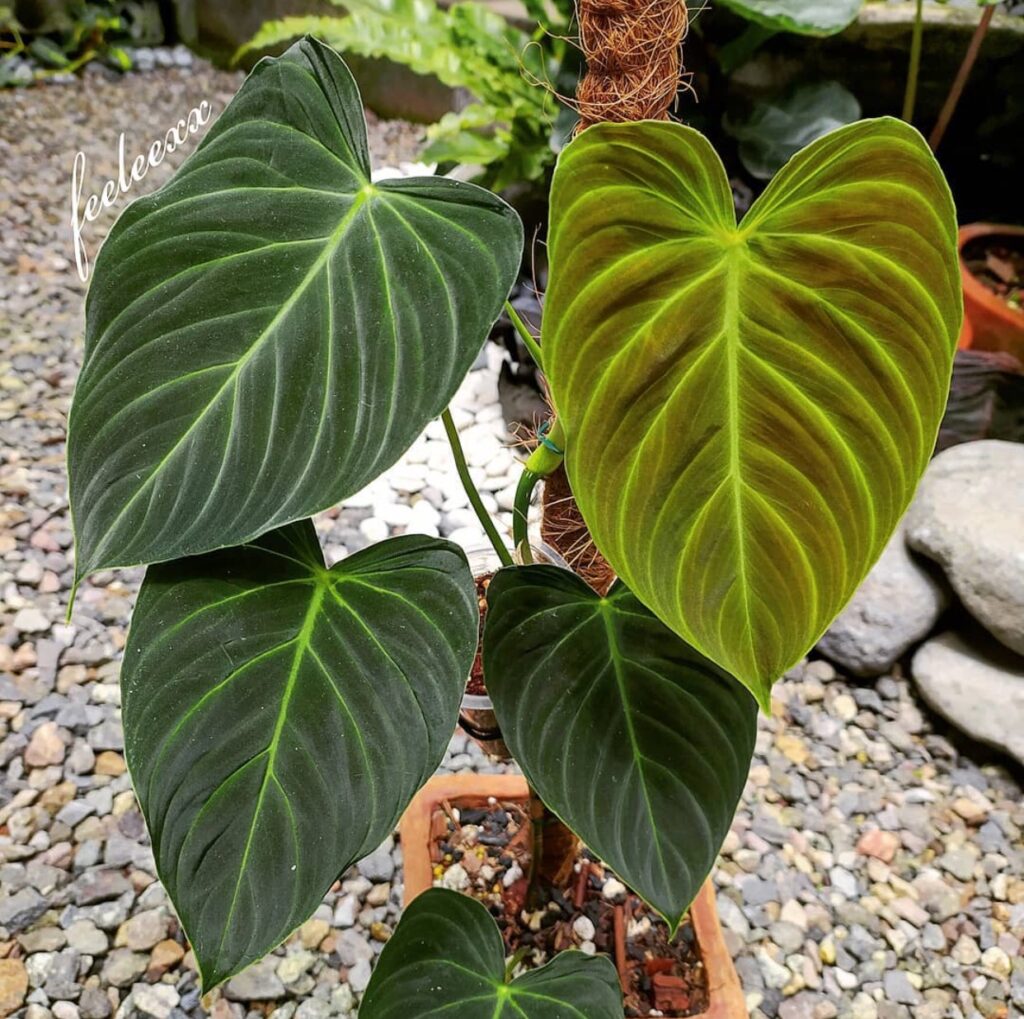
With its extensive and velvety leaves that are dark and silky green, a purple gloss, and beautifully prominent cream-colored veins, this highly attractive and desirable houseplant is a must-have for any collector!
Interested in knowing more about these plants? We’ve got it all covered for you. We’ll go through all of the basic information and all the essential steps on how to take care of this plant the best.
Philodendron Splendid Profile
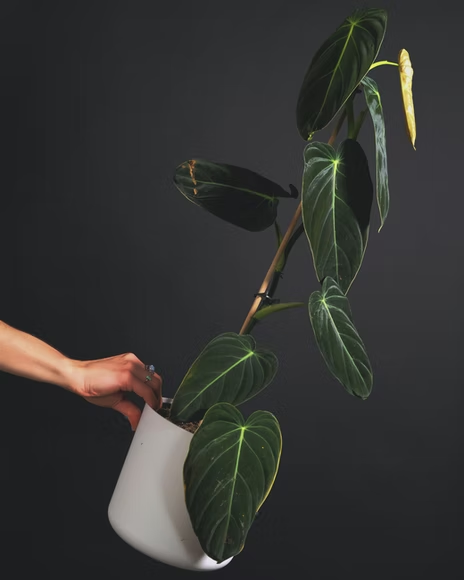
General Information
Philodendron splendid is a rare and elegant hybrid of Philodendron melanochrysum and Philodendron verrucosum, both of which are endemic to the rainforests of South America and the West Indies.
It is a plump, terrarium-friendly tropical vine belonging to the Araceae family – a close relative of Alocasias and Monsteras. It is also commonly known as the “Philodendron Glorious.”
It has huge, elongated heart-shaped leaves with velvety leaf texture, dark silky green with a purple polish, and attractively prominent cream-colored veins that will surely bring a touch of tropical flair to your garden spaces.
The entire plant may reach heights of 4 to 6 feet indoors, while outdoors, it can reach a length of up to 10 feet.
Etymology
The name “philodendron” comes from the Greek words “philo”, meaning “love” and “affection”, and “dendron,” meaning tree. So the Philodendron is loosely translated as “tree huggers” with these meanings. This is because they are often seen in the wild as tree climbers.
Flowering
When appropriately cultivated, mature Philodendrons will also yield rich-looking flowers and fruits. It blooms with tiny flowers with white or yellow stripes. Almost the bulk of the growth happens during the flowering season, from May to July, during spring to late spring.
Season of Interest and Purchasing
Philodendron splendid grows from May to July, from early spring to late spring. It produces healthy leaves, and people enjoy the velvety texture of the foliage, which makes it stand out in your house. This plant is a lovely decorative plant that may also be kept indoors in a container.
Philodendron splendid is affordable and commonly accessible at garden centers.
RELATED: Yellow? Goodbye! 7 Reasons Why Your Philodendron Is Changing Color
Growth
Philodendron’s Splendid growth rate is moderate to rapid, which indicates that if properly cared for, it may grow to be huge. It can grow to be 4 to 6 feet tall. Its leaves can spread to a breadth of one foot. They may also be 2 feet long.
Philodendron Splendid Overview
| Scientific name | Philodendron verrucusom x Philodendron melanochrysum |
| Common name/s | Philodendron Glorious |
| Family | Araceae |
| Growth Habit | Herbaceous, Epiphytic Vine |
| Height and Spread | up to 4 to 6 feet in height, and 2 feet in leaf spread |
| Classification based on life cycle | Perennial |
| Origin and Distribution | Native to South America and the West Indies |
| Climate Zone | Generally mild climate |
| USDA Plant Hardiness Zone | USDA Zone 10-11 |
| Color | Silky dark green, velvety, heart-shaped leaves with purple polish and cream veins |
Care Tips
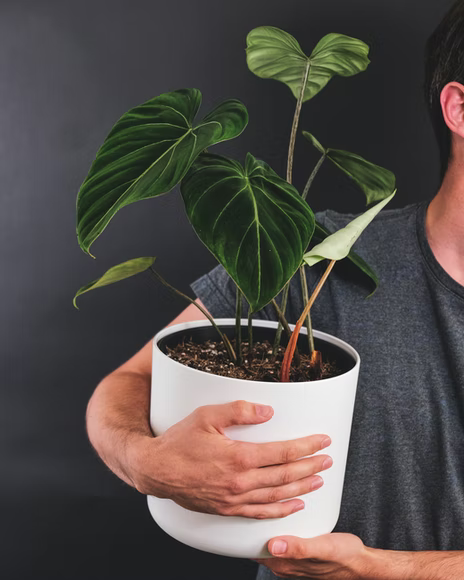
Light Requirement
Bright, indirect light, either natural or artificial lighting, goes best with Philodendrons. However, a north or east-facing window may be ideal if you plan to put it indoors.
South-facing windows also work but ensure that the plants are placed further away from the window so they do not get exposed to too much direct sunlight and cause their leaves to burn.
During winter seasons, your Philodendron might use a little help. You can use grow lights, especially if your plant is placed in darker home environments or office spaces where light is scarce and not readily available.
Your plant will grow even better if it has enough bright indirect light, so make sure they get the right amount they need.
If your Philodendron plant starts to develop leggy and long leaves and considerable distances between the internodes of the leaves, it means your plant is not receiving the right amount of light. Again, direct sun is definitely a no-no, or you will have crispy leaves!
Temperature Requirement
Like other tropical plants, Philodendron Splendid prefers warm temperatures ranging from 55 to 80 degrees Fahrenheit. It thrives in moderate to warm temperatures but cannot endure lower conditions. Always create a tropical rainforest-like climate to keep your plant happy.
Avoid temperature swings by keeping plants away from outside doors that open and close regularly. If temperature swings are frequent, the plant will suffer, and its leaves will not be healthy. Misting the plant might be a solution since it helps to retain moisture and reduce temperature fluctuation.
Water Requirement
Philodendron Splendid water requirement is generally the same as other Philodendrons. It prefers moist soil, damp but not soggy. This might take some balancing and getting used to, but you’ll learn its preferences once you’ve watered your plant long enough.
It is essential, though, to avoid overwatering as it can lead to root rotting, one of the main culprits of deaths of Philodendrons.
To water your plant, check first the soil. Stick your fingers into the topmost soil; if they are completely dry, your plant needs watering. Please pay attention to its leaves also. When it starts to have drooping leaves or yellow leaves, it means your plant is being overwatered or underwatered.
To avoid this, rectify your watering schedule to your Splendid to about twice a week, depending on your indoor air quality, climate, and moisture level. You may use tap water for this plant.
Humidity Requirement
Humid conditions are essential for tropical plants as they come from rainforests with moderate to high moisture levels. This is because they are exposed to heavy rain in their natural habitat and thrive in a moisture level of 60% and above.
However, as long as the humidity is at 40%, it will thrive. Ideally, an environment with high humidity is best for Philodendron gloriosum.
This plant requires a misty environment. When grown indoors, you may opt to use a humidifier to help in maintaining the required humidity level.
Soil Requirement
Philodendron Splendid thrives on well-drained, aerated soil that is also rich in organic matter for the roots. Blend the Philodendron Splendid soil with perlite, sphagnum moss, sand, coconut coir, or bark to give it room to flourish.
They thrive in fast-draining potting combinations and have a high content of organic materials.
In order to prevent being muddy or flooded, use this potting mixture. This will let extra moisture drain to avoid the pot from being saturated.
Fertilizer Requirement
During the growth season, Philodendron Splendid will require fertilizer to provide the nutrition it needs. Once fertilized on a regular basis, it grows well and produces healthy leaves.
Fertilize it once a month throughout the growing season with a balanced, water-soluble fertilizer such as organic and Espoma indoor plant food. It is a liquid that is high in micronutrients and nitrogen compounds.
Furthermore, using a balanced fertilizer, such as N-P-K, 10-10-10, or 20-20-20, at half the suggested strength is the best choice for fertilizer.
Space Requirement
Your plant will need planters or containers with efficient drainage holes so the soil does not get soggy for an extended period of time. Waterlogged soil leads to root rot, one of the biggest problems of Philodendrons and other houseplants.
Also, note that Philodendron Splendid is a creeping or climbing vine, so it will need longer, rectangular containers and a moss pole. Make sure to give this plant ample room to flourish. Although it may be grown in soil or pots, it prefers tiny areas and visually appealing containers like terrariums.
Unfortunately, unlike other Philodendrons, it does not thrive well in hanging or round pots.
Growing and Planting Tips
Propagation
Stem cuttings are the most convenient method for homegrown propagation of Philodendron verrucosum x melanochrysum. With a high success rate, it is known for rooting promptly in water or potting soil.
Furthermore, the growth of roots is promoted when the stem is covered in moist moss. A new plant is produced by dividing the roots from the stems and leaves.
Below are the detailed steps to successfully propagate Philodendron Splendid:
Propagation by Stem cuttings
Stem cutting in soil or water is an asexual propagation method that is effective well for Philodendron splendid. It essentially takes a portion of stem from a parent plant and manipulates it to make a new plant.
To grow Philodendron Splendid, you must follow a simple procedure:
- Pick a stem with a few leaf nodes and a few healthy leaves. Take a 4- to 5-inch stem cutting, trim off the excess foliage, and leave one or two leaves.
- Apply rooting hormone to the cut stem. Prepare a planter using small pots with a soilless potting medium, such as seed-starter mix or vermiculite. Place the prepared seed starting medium on top of the stem.
- Place the cuttings in a location that will provide them with a 50/50 ratio of shade to dappled sunlight. Fill your planter with slightly moist sphagnum moss, potting soil, or coconut coir. Don’t let it become waterlogged. Instead, give it water on a regular basis for two weeks.
It typically indicates that strong, new roots have been established when you notice that the cutting’s stem is sprouting new leaves. Move the cutting to a new pot with fresh potting soil once the roots have sufficiently grown.
RELATED: 11 Frequently Asked Questions on How to Care for a Philodendron Birkin
Pruning
Philodendron Splendid are fast growers. Since this plant is a natural climber, it also has a tendency to grow “leggy.” Hence, they require a lot of pruning. They need to be pruned every early spring or during the growing season.
Potting And Repotting
An ideal pot for Philodendron Splendid is the one that drains well, so the roots don’t rot from too much moisture. It grows well in any container. However, clay, ceramic, or terracotta pots may help expel excess moisture and avoid waterlogging.
Because of its fast-growing nature, this plant is prone to root-bound conditions. Consider repotting it every 1 to 2 years in the early spring. When repotting, make sure the pot has drainage holes, is two inches larger than the old one, and the potting mix is fresh and of high quality.
You may also mix your regular potting soil with horticultural charcoal and organic matter to facilitate your plant’s growth. An orchid potting mix is also beneficial for gloriosum. Just make sure to have a well-draining potting mix to avoid excess water to your plants.
| Light | Bright indirect light |
| Temperature | Intermediate to warm, 55-80 degrees Fahrenheit |
| Water | Once a week, increased in summer, decreased in winter |
| Soil | Airy, well-draining soil; not too loose |
| Fertilization | Regular household fertilizer, once a month |
| Space | Plenty of space to creep or climb |
| Propagation | Via stem cutting propagation |
| Blooming | Rarely blooms, enough sunlight and maturity needed |
| Pruning | Regular pruning |
| Potting | Regular potting mix, use of horticultural charcoal, perlite and coco coir |
Problems And Troubleshooting
Overwatering
If there is too much water or the soil is constantly moist, your plant will typically drown. The most prevalent reason for stunted, slow growth with yellowing leaves is overwatering. However, if your plants are yellowing but have not yet begun to wilt, you can retain them by starting to water them adequately.
Check for proper drainage in your planter and, if possible, create sufficient air space around the roots.
Underwatering
If the majority of the leaves seem pale and discolored, drooping, withering, and leaf curling, there might be several causes. A severe lack of water combined with excessive sunlight.
Plants will recover if you give them proper watering according to their watering schedule. Sadly, if your plants are dehydrated for a longer time, it may be too late to save them.
Nutrient Deficiency
Stunted growth, browning leaves, paler patterns, and other symptoms are all signs of nutrient shortage. Feed your plant to promote root penetration and stronger leaves in order to avoid this problem. However, if you have a high-quality organic potting mix, this houseplant doesn’t need a lot of fertilizer.
To fix this, apply the proper and balanced fertilizer; look for calcium-rich fertilizer. The strength of the nutrients must also be examined because too high a strength might harm plants and cause your Philodendron Spendid to develop slowly or with stunted growth.
Yellowing and Drooping
Yellowing of the leaves or other leaf discoloration, usually means your plant is getting an excess amount of direct sunlight. Therefore, you may opt to move it to a different placement where it will not receive extra direct light or where it’s shaded with sheer curtains.
Meanwhile, drooping may be a result of excessive or insufficient amounts of water. To address this, adjust your watering schedule appropriately and always check your soil before giving water your Splendid.
Diseases
Any plant can be susceptible to diseases if not properly taken care of. Particularly, plants of this family are affected by Septoria Leaf Spot and Alternaria Leaf Spot, which result in fungal growth. Usually, these are also due to over-watering the plants.
Take action immediately when you see yellowing (Septoria) or brown spots (Alternaria).
You can treat your plants with a copper-based fungicide, and make sure to be attentive to the watering conditions for it not to happen again.
Pests
Houseplants are also susceptible to pest problems; unfortunately, Philodendron is no exception.
If you observe the presence of pest infestation, the best thing to accomplish is to remove that plant and separate it from the other plants in your collection to avoid further infestation. These pests love to spread from plant to plant, so it is best to be proactive and isolate the infected plant.
The next thing to do, and frankly the easiest and simplest method, is to spray your plant with neem oil. Mix two teaspoons of neem oil and a teaspoon of soap in a spray bottle to make this spray. Add water to fill the bottle and shake properly.
Spray the plant lightly, including its undersides, and repeat the treatment every 5-7 days.
Neem oil is a natural pesticide that makes it difficult for these bugs to respirate.
Philodendron Splendid Pests And Diseases
| Common Pests/Diseases | Symptoms | Treatment and Prevention |
Common diseases include crown rot, stem rot, root rot, leaf spot, fungal diseases, and Xanthomonas infection | Yellowish rimming around black or dark brown spots on leaves | Avoid overwatering. Keep soil dry. Avoid too high humidity. Proper ventilation is needed around the plant. Remove infected parts of fungal infections to avoid spreading |
| Common pests include mealybugs, spider mites, aphids, and scales | Visible insects on the surface | Spray plant with warm, soapy water. If infestation is present, use insecticide or neem oil. Use diatomaceous earth. |
Flowering Problems
Although a Philodendron is a flowering plant, it must reach maturity before flowering. When cultivated properly, mature Philodendrons will also yield rich-looking blooms and fruits. It blooms in tiny flowers with white or yellow stripes.
The main issue is that the Philodendron flowers once the plant only matures, which takes around 10 to 15 years, and only blooms for about two days per summer.
Problems with People and Animals
Toxicity
All Philodendrons, including Philodendron Splendid, are toxic to people and pets. The calcium oxalate crystals found in the leaves and stems make Philodendron Splendid toxic. This includes Philodendron Splendid young leaves and other plant parts.
Make sure to place the plant out of reach from small children, cats, and dogs.
Philodendrons Plants Meaning and Symbolism
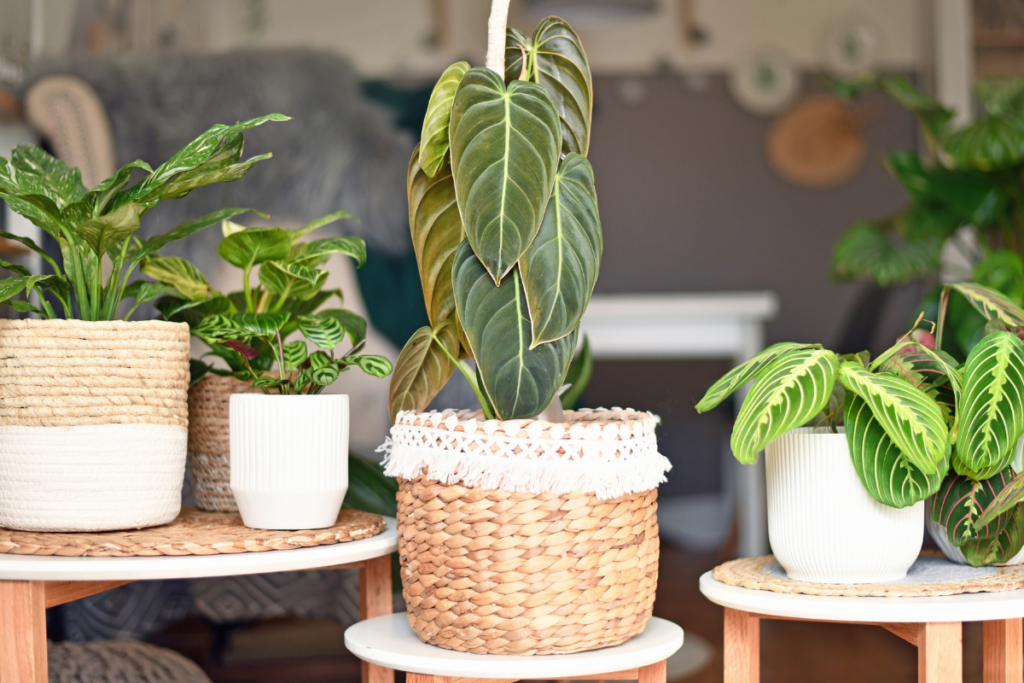
Philodendrons are said to symbolize love of nature, perfect for plant lovers and those who have a strong passion for eco-friendly living. They also symbolize personal growth, so they would make an ideal gift for someone who is going through major life events or making personal improvements.
| General Meaning | love of nature, passion for eco-friendly living |
| Symbolism | Personal growth |
Landscaping And Gardening Ideas

Companion Plants
Other tropical plants go well with Philodendrons, especially Monsteras and other Aroids. Some of the plants you may consider include bird of paradise, areca palms, fire spike, heliconia, variegated arboricola, croton, chenille plant, and pentas.
Some of these plants will have additional colors and hues of warm oranges and reds, which will perfectly complement your cool dark greens.
Landscaping Ideas
Medium-sized Philodendrons go well as accents inside a humid room or a cozy deck or patio. A full plant can also be placed in the corner of the house or along the entryway. Outdoors, it can be a filler plant for a garden corner, in between palm trunks, or under tall trees.
It can also be placed near pools to add even more tropical vibes as long as it won’t get splashed at.
| What to plant with | Other Aroids, Bird of Paradise, Areca Palms, Fire Spike, Heliconia, Variegated Arboricola, Croton, Chenille Plant, Pentas |
| What NOT to plant with | Basically nothing |
Conclusion
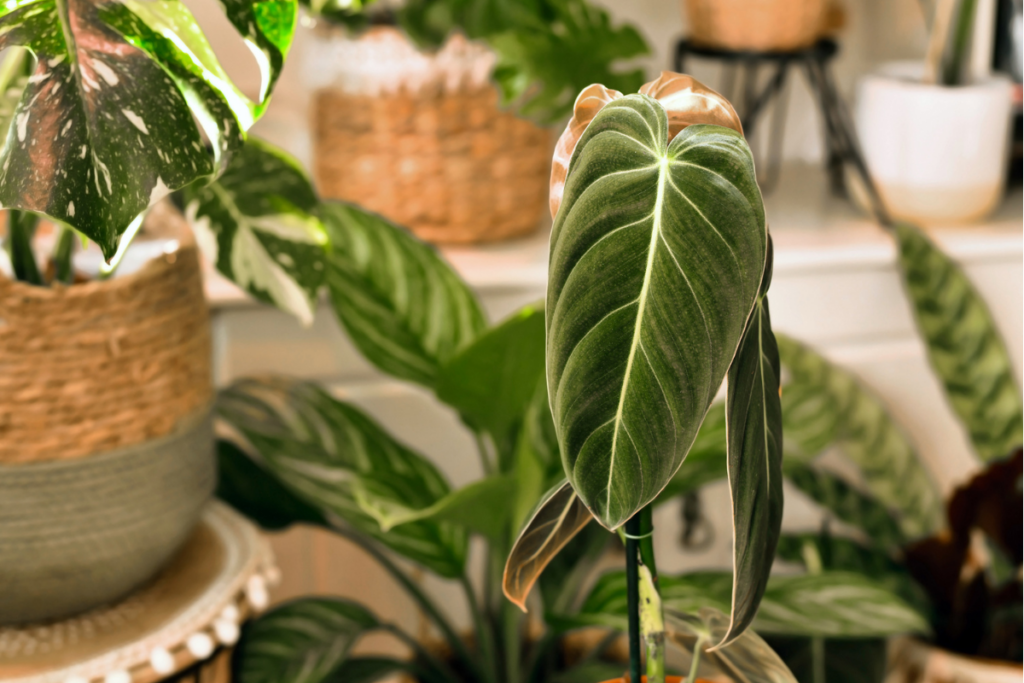
Given its huge, stunning leaves and easy-to-follow care and maintenance, no wonder why the Philodendron Splendid is a sought-after plant. So when you get your hands into these beauties, make sure to hold on tight and don’t let go!
This plant will surely be a real treat, especially with its fast, passing growth, exquisite markings, and majestic display.
Just make sure to follow the tips above, and your plant will surely give back the love they take from you.
Frequently Asked Questions
Is Philodendron Splendid fast-growing?
The Philodendron Splendid is a relatively fast-growing type of Philodendron. This is a great characteristic of this plant since they are sold mostly as node cuttings or small plants because of their rare habit.
Is Philodendron Splendid easy to care for?
Although it could be hard to get a hand on the Philodendron Splendid, it is easy to care for. The plant routine needed for this plant to grow healthy is pretty straightforward and easy to follow. Beginners can surely try to grow this plant in their homes.
How big does Philodendron Splendid get?
The majestic foliage of this plant can grow up to 4-6 feet when grown indoors and 10 feet in the wild. The leaf spread can grow up to 2 feet in length.
Is Splendid an Anthurium?
Definitely not. Splendids are members of the genus Philodendrons and not of Anthuriums. However, they are closely related since they come from the family Araceae. The same family of Alocasias and Monsteras.
Is Philodendron Splendid rare?
Philodendron Splendid is rare, and in high demand; that is why it is expensive.
Editor’s Recommendations
Philodendron rugosum: The Care, Propagation, and Watering Guide You Need
Philodendron White Princess: The Complete Care, Propagation, and Watering Guide You Need
Philodendron Spiritus Sancti: The Best and Complete Care, Watering, and Propagation Guide







